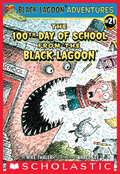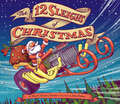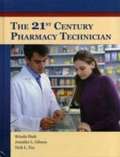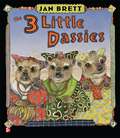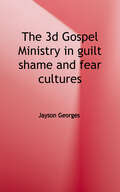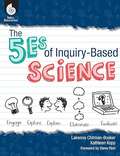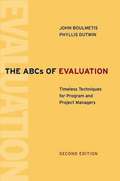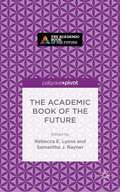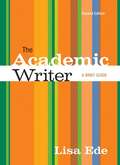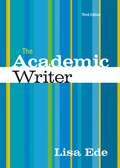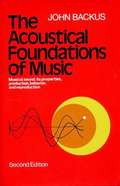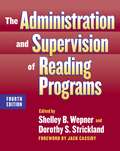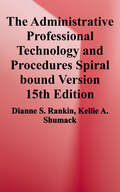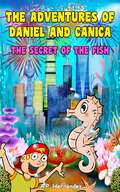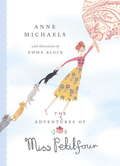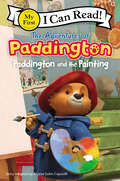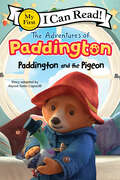- Table View
- List View
The 100th Day of School from the Black Lagoon (Black Lagoon Adventures #21)
by Mike ThalerThese fun-filled chapter books mix school, monsters, and common kid problems with hilarious results. You'll scream with laughter!Hubie's class is celebrating the 100th day of school by having each student bring in 100 of something. But Hubie has no idea what to choose. Should he go with 100 hairs on his head? 100 baseball cards? What can Hubie pick out of all the hundreds of 100 items he could bring?
The 12 Sleighs of Christmas
by Sherri Duskey RinkerSanta’s sleigh gets a makeover in this rhyming, vehicle-themed take on the 12 Days of Christmas from a #1 New York Times–bestselling author.Which elf will build the coolest sleigh for the Christmas ride? Santa will decide!When the elves discover that Santa’s sleigh is in a terrible state, they let their imaginations go wild—and soon there are sleighs of every kind, inspired by big rigs, motorcycles, zeppelins, and much more!The #1 New York Times bestselling author of Goodnight, Goodnight, Construction Site and the celebrated illustrator of Michael Chabon’s The Astonishing Secret of Awesome Man, team up for spirited vehicular silliness and classic Christmas cheer in this turbo-charged read-aloud destined to become a holiday classic.Perfect for fans of Mr. Willowby’s Christmas Tree, Bear Stays Up for Christmas, and Goodnight, Goodnight, Construction Site.Praise for The 12 Sleighs of Christmas“A splendid choice for any holiday read-aloud collection wishing to incorporate STEM concepts.” —School Library Journal“Rinker’s zippy rhymes. . . . and Parker’s cartoons. . . . mix magic and mechanics as the elves’ imaginations and talents run wild.” —Publishers Weekly“Kids who are obsessed anything on wheels will especially enjoy this rhyming tale.” —Parents Magazine“Revels in imaginative detail.” —The Horn Book MagazineChicago Tribune Best Children’s Books of the Year
The 21st Century Pharmacy Technician
by Nick L. Tex Jennifer L. Gibson Brinda ShahThe 21st Century Pharmacy Technician covers the foundations and principles that a student needs to know in order to practice as a pharmacy technician and sit for the certification exam. Students are given an introduction to the profession from the perspective of both community and institutional pharmacy settings. With accessible language and an easy-to-read format, this text helps students grasp concepts easily. It provides a comprehensive introduction to the pharmacy profession, pharmacy laws, pharmacology, drug dosages, drug safety, and more, in preparation for a future as a pharmacy technician. Topics covered include:#149; Laws, Regulations, and Standards#149; Pharmacy Math#149; Diseases and the Drugs Used in Treatment#149; Dosage, Administration, and Dispensing of Medications#149; Medication Safety#149; Sterile and Non-sterile Compounding#149; Communication#149; Business of the Community Pharmacy#149; Managing the Patient Profile#149; Processing Prescriptions
The 3D Gospel: Ministry in Guilt, Shame, and Fear Cultures
by Jayson GeorgesLearn How the Gospel Speaks to Guilt, Shame, and Fear Cultures! <p><p>Western theology emphasizes forgiveness of sins, but people in the Majority World covet honor or spiritual power. The 3D Gospel is a concise, practical book explaining the world's three primary culture types, and how the gospel addresses guilt, shame, and fear. <p><p>In today's globalized world, Christians need a three-dimensional gospel for all cultures. Is your gospel 3D?
The 45-Day GRE Vocab Book
by Aristotle PrepThe 45-Day GRE Vocab book is a unique book to prepare for GRE vocabulary. It takes away the boredom of memorizing hundreds of words by making learning new words interesting and engaging. The book contains 45 fun-to-do exercises that help you master the essential words required for acing the GRE Verbal section.
The 50 State Gems and Minerals: A Guidebook for Aspiring Geologists
by Yinan WangAn engaging kids' guide to the official US state gems and minerals by award-winning author Yinan Wan. How many states claim quartz as their official state gem? This guidebook answers this question and more as it explores the treasures that are designated official state gems and minerals. More than 150 photographs showcase these marvels, from the Star Blue quartz of Alabama to the jade nephrite of Wyoming. Each state entry is presented with details about the state gem and mineral, with pictures of each, and a map of the state showing where the gem or mineral can be found. Some states do not yet have designated gems or minerals, and suggestions and guidance are provided so that the reader can lead the way in getting one designated. Museums and parks with minerals are listed in the appendix so readers can go see specimens in person. Encyclopedic yet easy to read, this book is great for mineral and gem enthusiasts and future geologists of all ages.
The 5Es of Inquiry-Based Science
by Lakenna Chitman-Booker and Kathy KoppThis resource supports core concepts of STEM instruction and specifically addresses the connection between technology and the 5Es. Adapting to the changing technological worldis crucial in all fields of education, and The 5Es of Inquiry-Based Science helps teachers integrate their instruction strategies to incorporate technology while meeting the demands of today’s science standards (both quantitative and qualitative). With this resource, teachers can effectively promote a positive culture about inquiry and encourage active, engaged participation from students.
The Abcs Of Evaluation: Timeless Techniques For Program And Project Managers
by Phyllis Dutwin John BoulmetisThe second edition of the bestselling The ABCs of Evaluation offers a thoroughly revised and updated version of that classic book. Written for any program type or setting, The ABCs of Evaluation shows how to select participants for the evaluation and how to deal with multiple goals and objectives-including those of the organization, the staff, and the client. The authors describe different evaluation models, illustrate the circumstances under which each model can be used, and offer tips on identifying data sources and collecting the data itself. This new edition is filled with illustrative new cases and scenarios from various evaluation realms in social sciences, education, and human services. The book also contains information on how to negotiate the evaluation contract. Throughout the book, there are charts, graphs, models, and lists to help organize, extend, and facilitate the understanding of each evaluation concept.
The Academic Book of the Future
by Rebecca E. Lyons Samantha J. RaynerThis book is open access under a CC-BY licence. Part of the AHRC/British Library Academic Book of the Future Project, this book interrogates current and emerging contexts of academic books from the perspectives of thirteen expert voices from the connected communities of publishing, academia, libraries, and bookselling.
The Academic Writer: A Brief Guide (Second Edition)
by Lisa EdeThe Academic Writer is a brief guide to the essentials of academic writing and research. The text helps students think rhetorically and make effective choices as they write.
The Academic Writer: A Brief Guide (Third Edition)
by Lisa EdeWritten in Lisa Ede's accessible, supportive style, The Academic Writer is an affordable, brief guide to the essentials of academic writing and research. By framing reading and writing situations in terms of the writer, reader, text, and medium, Ede helps students think rhetorically and make effective choices. The text provides abundant coverage of reading, including a new chapter--"Reading on Page and Screen"--that helps students match device to purpose, and a second chapter of strategies for active and critical reading. It emphasizes analysis and synthesis, key skills required to master the moves of academic writing. And it provides advice on writing in the disciplines as well as numerous student models. With its updated coverage of research and its attention to visuals and design, The Academic Writer is the perfect introduction to college writing--at a great price.
The Acoustical Foundations of Music (2nd edition)
by John BackusThe original purpose of Professor Backus's book was to collect and organize the scattered results of research, past and present, in the areas of scientific knowledge that are relevant to music: the physiological properties of sounds; the effect of acoustical environment; the acoustical behavior of musical instruments; and the various applications of electronics and computers to the production, reproduction, and composition of music. The aims and organization of the second edition remain the same; the results are more complete and up-to-date.
The Administration And Supervision Of Reading Programs
by Dorothy S. Strickland Shelley B. WepnerOffering specific guidelines that literacy leaders can use to improve their programs, this text covers selecting materials, assessing the quality of teachers, providing staff development, working with different types of learners, and incorporating writing and technology.
The Administrative Professional: Technology and Procedures
by Kellie A. Shumack Dianne S. RankinThe Fifteenth Edition of this trusted text focuses on preparing you for employment in today's increasingly dynamic, digital, and global environment. The authors emphasize helping you to understand employers' expectations; build confidence; and develop the knowledge and skills necessary to become a strong, competent employee and leader. <p><p>The Administrative Professional: Technology and Procedures, Fifteenth Edition, features updated content, an appealing design, an abundance of practical applications, and a new MindTap website to enhance learning and engage your interest right from the start.
The Adventures Of Daniel And Canica: The Secret of the Fish
by A. P. HernándezDaniel is an 8-year-old boy and Canica his faithful chihuahua. Together, they've had all kinds of adventures, but none like this one. Follow them as they explore the ocean, meet the inhabitants of Bubble City and discover the secret of the fishes...
The Adventures of Miss Petitfour (The Adventures of Miss Petitfour)
by Anne MichaelsThe magical adventures of an eccentric Mary Poppins-esque heroine and her flying feline charges, sure to charm readers big and small. The first book for children by an internationally acclaimed novelist and poet. Miss Petitfour enjoys having adventures that are "just the right size - fitting into a single, magical day." She is an expert at baking and eating fancy iced cakes, and her favorite mode of travel is par avion. On windy days, she takes her sixteen cats out for an airing: Minky, Misty, Taffy, Purrsia, Pirate, Mustard, Moutarde, Hemdela, Earring, Grigorovitch, Clasby, Captain Captain, Captain Catkin, Captain Cothespin, Your Shyness and Sizzles. With the aid of her favorite tea party tablecloth as a makeshift balloon, Miss Petitfour and her charges fly over her village, having many little adventures along the way. Join Miss Petitfour and her equally eccentric felines on five magical outings -- a search for marmalade, to a spring jumble sale, on a quest for "birthday cheddar", the retrieval of a lost rare stamp and as they compete in the village's annual Festooning Festival. A whimsical, beautifully illustrated collection of tales that celebrates language, storytelling and small pleasures, especially the edible kind!
The Adventures of Paddington: Paddington and the Painting (My First I Can Read)
by Alyssa Satin CapucilliBased on the new Nickelodeon animated series and inspired by the classic books, this 32-page My First I Can Read is perfect for shared reading with a child.When Mrs. Brown can’t find inspiration for her painting, she enlists the help of Paddington. The Adventures of Paddington is an animated preschool series starring Paddington, a polite little bear who lives with the Brown family at 32 Windsor Gardens. He is kind, curious, and rather accident-prone. Taking a lead from Michael Bond’s original books, and the spirit of the hugely successful Paddington movies, each new Paddington story is packed with vibrancy, humor, and charm.
The Adventures of Paddington: Paddington and the Pigeon (My First I Can Read)
by Alyssa Satin CapucilliBased on the new Nickelodeon animated series and inspired by the classic books, this 32-page My First I Can Read is perfect for shared reading with a child.When a pigeon falls down the chimney into the Browns' living room, Paddington makes a new friend. The Adventures of Paddington is an animated preschool series starring Paddington, a polite little bear who lives with the Brown family at 32 Windsor Gardens. He is kind, curious, and rather accident-prone. Taking the lead from Michael Bond's original books and the spirit of the hugely successful Paddington movies, each new Paddington story is packed with vibrancy, humor, and charm.

